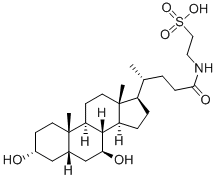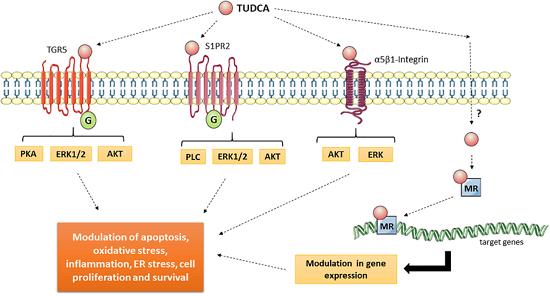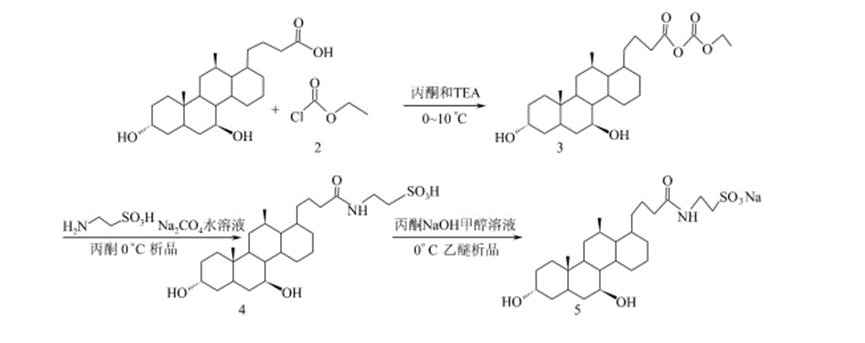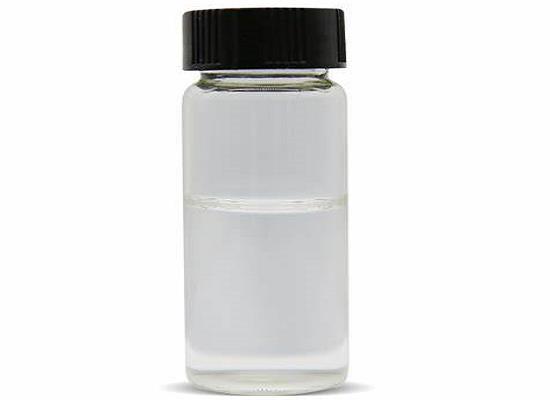Tauroursodeoxycholic Acid: Characteristics and Therapeutic Effect on Alzheimer's Disease
General Description
Tauroursodeoxycholic acid, a hydrophilic bile acid, shows significant therapeutic potential for treating neurodegenerative disorders such as Alzheimer's disease. Tauroursodeoxycholic acid is notable for its ability to cross the blood-brain barrier, enhancing cognitive functions like spatial learning and memory retention in animal models. Its effectiveness in improving cognition is attributed to several mechanisms: reducing neuroinflammation, modulating the process of apoptosis, and stabilizing mitochondrial functions within neurons. These findings suggest that Tauroursodeoxycholic acid could potentially improve cognitive abilities without negatively affecting normal brain functions. However, despite its promising results in preclinical studies, extensive research is needed to fully determine its efficacy and explore the underlying mechanisms in human subjects, aiming to verify if similar benefits can be replicated in human clinical settings. This is crucial for its development into a viable treatment option for Alzheimer’s and related neurodegenerative diseases.

Figure 1. Tauroursodeoxycholic acid
Characteristics
Chemical Composition and Formation
Tauroursodeoxycholic acid, initially derived from bear bile and known for its extensive use in traditional Chinese medicine, is a hydrophilic bile acid with significant therapeutic properties. This compound was first identified in 1902 and has since been recognized for its potential in treating various health issues, particularly neurodegenerative diseases. Tauroursodeoxycholic acid is formed by combining the amino group of taurine with the carboxyl group of ursodeoxycholic acid. Its ability to cross the blood-brain barrier makes Tauroursodeoxycholic acid particularly effective in neurological applications.
Medical Applications
The United States Food and Drug Administration approved Tauroursodeoxycholic acid for specific cholestatic liver diseases, recognizing its safety and efficacy. Beyond its initial medical applications, Tauroursodeoxycholic acid has been studied for its protective effects on nerve cells, particularly in regulating cell apoptosis. This mechanism is crucial in its role against neurodegenerative conditions like Parkinson's disease, amyotrophic lateral sclerosis, and diabetes retinopathy. Tauroursodeoxycholic acid's therapeutic benefits extend to its excellent safety and tolerance profiles, making it suitable for long-term use in clinical settings. Additionally, Tauroursodeoxycholic acid is not only extracted from natural sources but also synthesized chemically, ensuring its availability for widespread medical use. Overall, Tauroursodeoxycholic acid holds promising potential in medical science, particularly in treating diseases that involve neurodegeneration and cellular dysfunction. 1
Therapeutic Effect on Alzheimer's Disease
Cognitive Enhancement in Animal Models
Tauroursodeoxycholic acid has shown considerable promise in mitigating the progression and symptoms of Alzheimer's disease, demonstrating its potential as both a preventive and therapeutic agent for cognitive impairments. Research involving animal models has revealed that Tauroursodeoxycholic acid can effectively enhance cognitive functions such as spatial learning, memory retention, and recognition, which are often compromised in Alzheimer's disease. In a notable study, it conducted a randomized controlled trial where Alzheimer's disease model mice, along with wild type mice, were fed a diet supplemented with 0.4% Tauroursodeoxycholic acid or a regular diet over six months. Subsequent assessments using the Morris water maze and other cognitive tests indicated significant improvements in spatial learning and memory abilities in the mice receiving Tauroursodeoxycholic acid, without adversely affecting the cognitive function of normal mice.
Reversal of Memory Deficits
Studies by Nunes et al. (2012) demonstrated that Tauroursodeoxycholic acid could reverse memory deficits in Alzheimer's disease model mice. Specifically, it enhanced discrimination between conditioned and novel contexts, addressing a common challenge in Alzheimer's disease. This research underscores Tauroursodeoxycholic acid's ability to potentially restore cognitive function impaired by Alzheimer's pathology, indicating a promising therapeutic avenue for this devastating condition.
Mechanisms and Future Prospects
Further investigations, including studies by Dionísio et al. (2015), have highlighted potential mechanisms underlying Tauroursodeoxycholic acid's therapeutic effects. These mechanisms include the reduction of neuroinflammation, modulation of apoptosis in neural cells, and possibly the stabilization of mitochondrial function and reduction of oxidative stress in brain tissues. Such multifaceted benefits underscore Tauroursodeoxycholic acid's significant potential as a therapeutic intervention for Alzheimer's disease, warranting continued clinical exploration to validate its efficacy and safety in human subjects. 2
References:
[1] SONG H, LIU J, LI J, et al. Frontiers | Tauroursodeoxycholic acid: a bile acid that may be used for the prevention and treatment of Alzheimer’s disease[J]. Frontiers in Neuroscience, 2024, 21 1: 317-339. DOI:10.3389/fnins.2024.1348844.Related articles And Qustion
Lastest Price from Tauroursodeoxycholic acid manufacturers
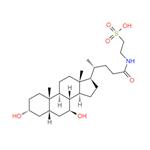
US $0.00-0.00/KG2025-09-25
- CAS:
- 14605-22-2
- Min. Order:
- 1KG
- Purity:
- 99
- Supply Ability:
- 1000KG
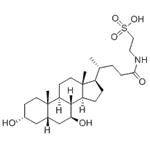
US $0.00/kg2025-09-08
- CAS:
- 14605-22-2
- Min. Order:
- 1kg
- Purity:
- 99%min
- Supply Ability:
- 20tons
